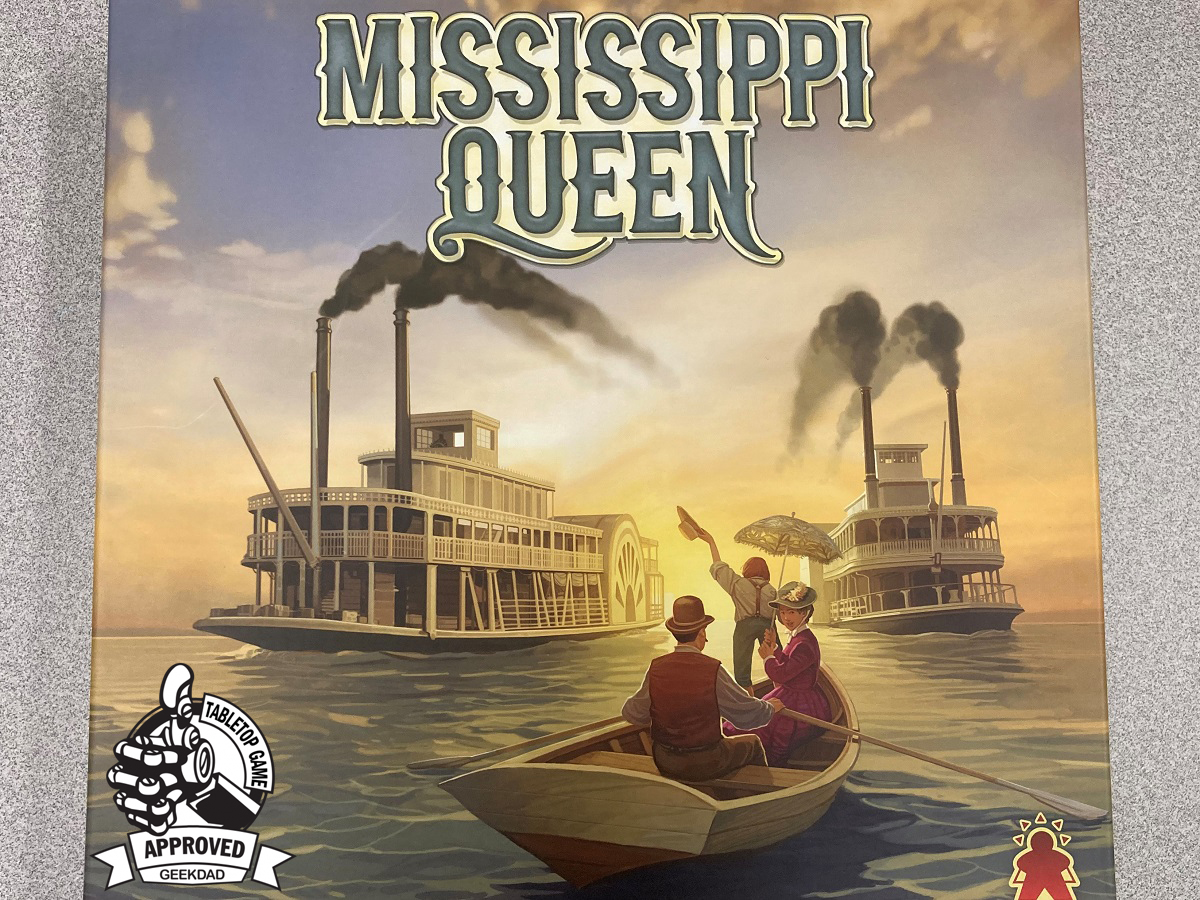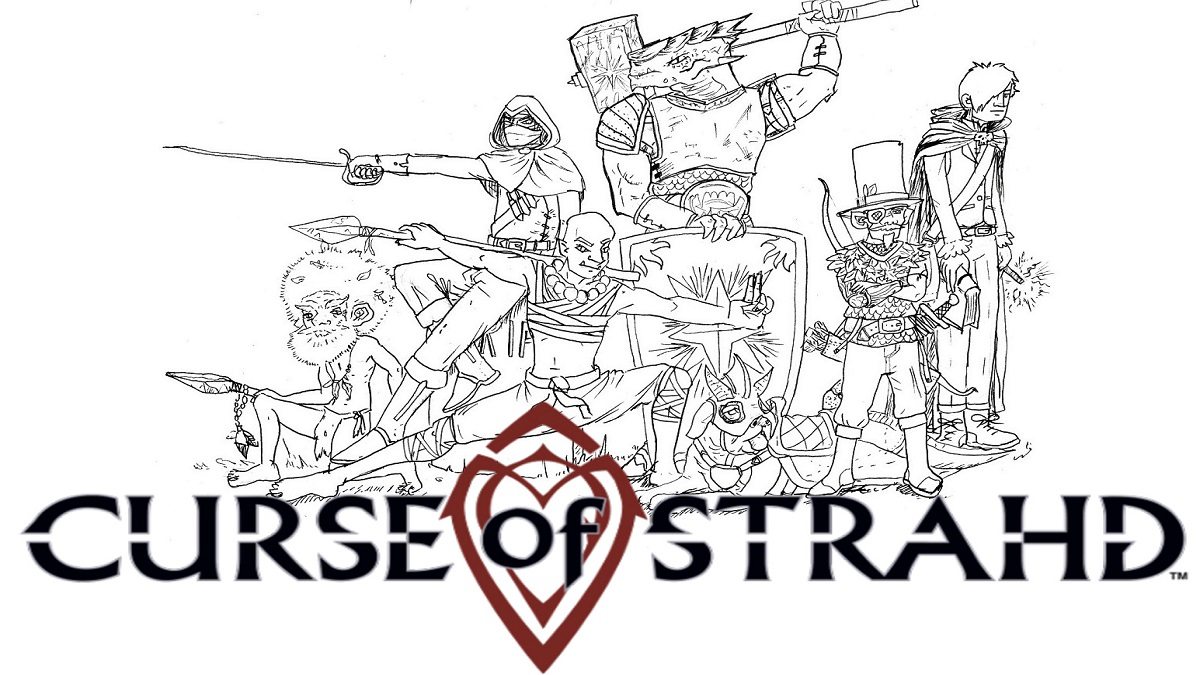In the days of Mark Twain, steam-powered paddlewheelers sailed up and down the mighty Mississippi River from New Orleans to St. Louis and beyond. Captains on the river wanted to pilot the fastest steamer on the river and claim for the title for their boat, Mississippi Queen.
What Is Mississippi Queen?
Mississippi Queen is a racing game game for 2-6 players, ages 10 and up, and takes about 45 minutes to play. It’s currently available for around $39 from several retailers including Amazon.
Mississippi Queen was designed by Werner Hodel and published by Super Meeple, with illustrations by Christophe Swal and Fabrice Weiss. The game was the 1997 Spiel des Jahres Game of the Year Winner. This reissue includes advanced rules and tiles as well as the Black Rose expansion.
Mississippi Queen Components
The game includes the following:
- 18 Mississippi River tiles
- 7 Paddlewheelers
- 7 Speed paddlewheels
- 6 Coal paddlewheels
- 1 Black Rose coal paddlewheel
- 16 passengers
- 1 measuring stick
- 1 Finish tile
- 1 turn order board
- 1 Direction die
- 13 Boat tokens
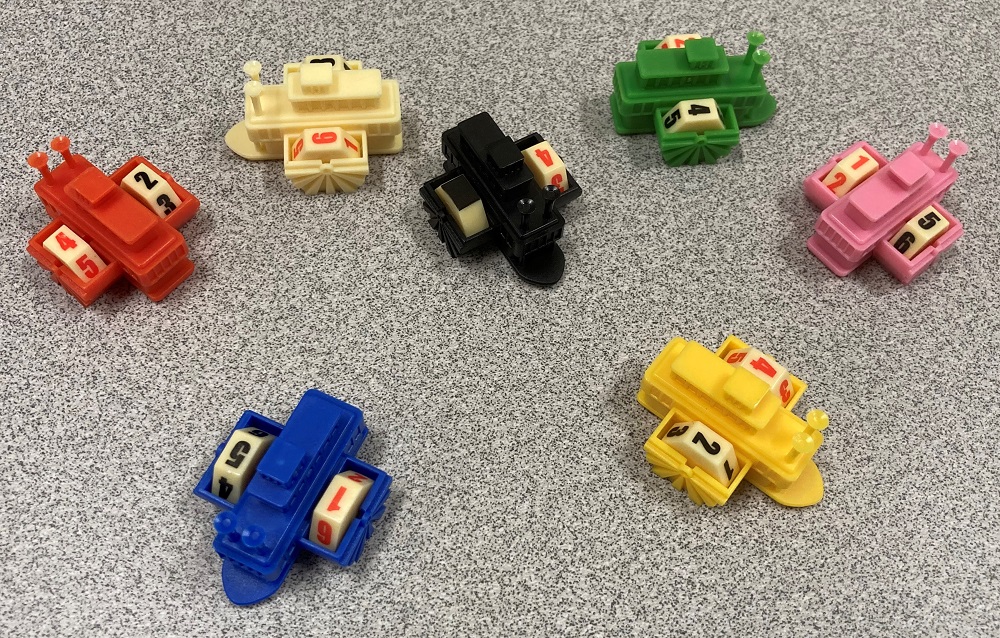
Mississippi Queen includes six paddlewheelers for games of up to six players. The black paddlewheeler is for the Black Rose expansion and is controlled by whichever player is in last place. The red-numbered paddlewheels show the boats speed while the black-numbered paddlewheels represent the boat’s coal supply. Both can be rotated to show the current speed and coal values respectively.
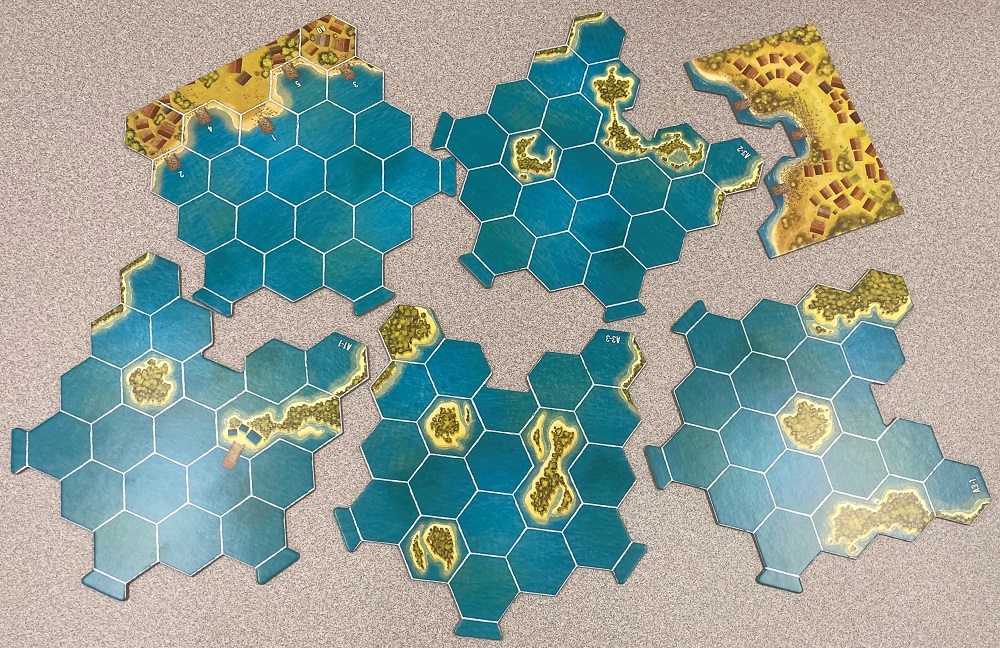
The game includes a start tile, and end tile and 11 other Mississippi River tiles. They connect together in three different directions chosen at random during gameplay so a different course is created each time you play. There are six additional tiles used for the advanced rules.

Passenger miniatures are placed on docks along the river. Players must collect two passengers during the course of the race. Once collected, the passengers are placed on the large boat token of the player’s color to show they are riding aboard that boat.

Since the order players go can change each round, the turn order board helps keep track of who goes first and so forth.

The unique die is rolled whenever a new Mississippi River tile is to be placed. The three different arrow icons direct the tile to be place straight ahead or to form a bend in the river to the right or to the left.
How to Play Mississippi Queen
The Goal
The goal of the game is to collect two passengers and be the first paddlewheeler to stop at one of the docks on the finish tile.
Setup
Place the start tile in the middle of the table. Then shuffle the 11 Mississippi River tiles face down. Select the top one and attach it to the start tile in a straight line. Set aside the number of passenger miniatures based on the number of players. For 2-3 players, use 8 passengers, 12 passengers for 4 players, and 16 passengers for 5-6 players.
Each player then chooses a boat of a different color with the exception of black. Insert a red-numbered speed wheel on the left side and a black-numbered coal wheel on the right side. Set the speed to 1 and the coal to 6. Players also place a large boat token of their color in front of them to keep track of passengers they will pick up. Small boat tokens of the players’ colors are placed near the turn order board.

Shuffle the small boat tokens and place them in a random order on the turn order board. Players then place their paddlewheeler on the numbered dock on the start tile that matches their turn order. If there is a sixth player, they place their paddlewheeler on land next to dock 3 or 5. They then place their boat in the water once it is there turn. Players can choose any orientation when they place their boat on the dock. They just need to face one of the flat side of the hexagonal shaped space. You are now ready for the race to begin.
Gameplay
Turn Order
During each round, the players take turns in the order shown on the turn order board. For the first round, the turn order is randomly assigned at the start. However, starting with the second round, turn order is determined by who is farther down the river. If it is not obvious which boat is ahead, place the measuring stick parallel to the tab connecting the the current tile the boats are on with the next tile. Then slide the measuring stick, not rotating the orientation, until it touches the space with the boat. That boat is ahead. Orientation of the boats do not matter. If two boats’ spaces are both touching the measuring stick, the boat with the highest speed is ahead. If they are still tied, then the boat with the most coal is ahead. Finally, if they are still tied, the boat to the right is ahead.
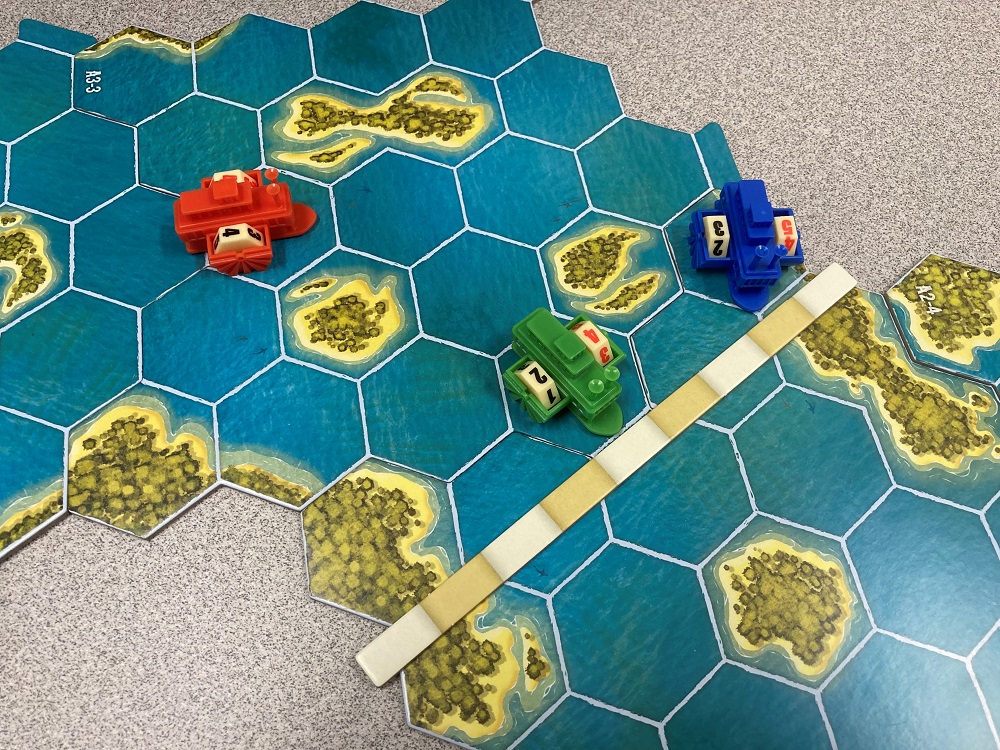
Moving
Once the turn order is determined, the first player then moves their paddlewheeler. Before moving your boat, you can increase or decrease your speed by one for free. For each additional change to speed, you must use one of your coal. For example, a boat starts at speed one. The player can change it to speed two for no cost. If they wanted to change it to speed 3, they would need to reduce their coal by one. For speed 4, they would reduce their coal by 2.
After the speed for the turn is set, the player must move their paddlewheeler that many spaces. During the entire move, the player may rotate their boat 60 degrees (or one hexside) for free. Each additional 60 degree turn costs 1 coal, so a 180 degree turn would cost 2 coal.
If a boat uses its last unit of coal, remove the coal wheel from the boat to show that it has zero coal. It remains in the race but can only change its speed by one unit per round and only make one 60 degree turn per round.

During a move, you are not allowed to cross or stop on an island or leave the river. Since your boat must move its complete speed in spaces, if you would run into an island or leave the river, you must spend coal to prevent this. If you still can’t avoid it, then the boat hits the island or bank of the river and stops. You cannot move during the next round as your boat makes repairs. Then on the following round, speed is set at one and the boat may leave the current space in any direction the player chooses.
When a player’s paddlewheeler enters the last tile so far revealed, they stop their movement and roll the die. Draw the top tile from the stack and flip it over. Attach it to the river in the orientation shown on the dice: straight ahead or to the right or left. If the new tile would ever touch another tile with the exception of the tile to which it is connecting, reroll the die until you get another result so the course does not loop in on itself. If the new tile has any blue or red docks, place the number of passengers on that island as directed by the rules depending on the number of players. For 2-3 player games, place one passenger per dock. In a 4 player game, place one passenger per red dock and 2 per blue dock while for 5-6 players games, place two passengers per dock of either color.
Pushing Another Boat
Your boat can enter the space occupied by another player’s boat if you push it. It costs an additional movement point to push another boat. So instead of one point to enter the space, it costs two. Before entering that space, move the other boat to any legal adjacent space except the one your boat is currently in. The other player can immediately reorient their boat in any direction they choose. Then move your boat into that space.
Picking Up Passengers
Each player must pick up two passengers before they get to the end tile. In order to pick up a passenger, you must stop at a space with a dock with a speed of 1. It does not matter which way your boat is facing. Take a passenger from the island and place it on your large boat token. Each boat can only carry two passengers. Also, if you boat’s speed is one, and you are pushed into a dock with a passenger, you can immediately pick that passenger up. Players can only pick up one passenger per island even if there are two there.
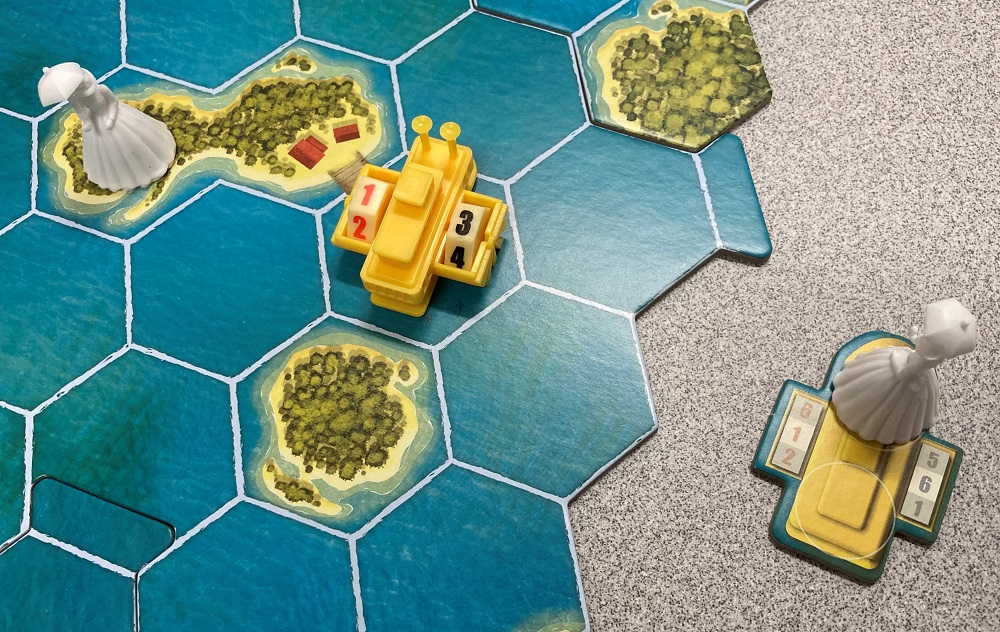
The Finish
After the last river tile from the stack is placed, the player in the lead rolls the die and places the finish tile. The winner of the race is the first boat to reach one of the three docks on the finish tile with a speed of one and two passengers aboard. Remove that boat from the tile. The game ends when all the boats but one have docked with their two passengers aboard.

Advanced Rules
Mississippi River also includes advanced rules which had previously been only included with expansions to the game. These rules add new tiles as well as the ability to transfer coal. Two of the new tiles feature coal depots. If a ship stops with speed 1 at a block dock, they can set their coal to 6. Other tiles include hazards such as driftwood and sandbars. Driftwood spaces can be entered at the cost of two movement points. However, at the end of your turn, you must decrease your speed by the number of driftwood spaces you entered. If a boat enters a sandbar space, it becomes stuck. Its movement ends immediately and speed drops to 1. On the next turn, you must spend a coal to move either one space forward or backward. If you move backward, you cannot change your speed during the next turn from one. The archipelago tile has six islands and requires a lot of turning to maneuver through it.

The Black Rose adds the black paddlewheeler to the game. It is only for 2-5 player games and starts last in the turn order. The Black Rose has an unlimited amount of coal, but can only spend one coal per round. Its coal wheel has only black and white sides. It starts a round with the black side and is rotated to the white side as soon as it uses it for extra changes in speed or extra turns. The player who is last in the turn order controls the Black Rose. However, the Black Rose gets its spot in the turn order just like all the other boats. The player who controls the Black Rose moves it like any other boat. If their boat is adjacent to the Black Rose and at the same speed at the end of either boat’s move, the player can refill their coal up to six. The Black Rose cannot pick up passengers and cannot win the race.
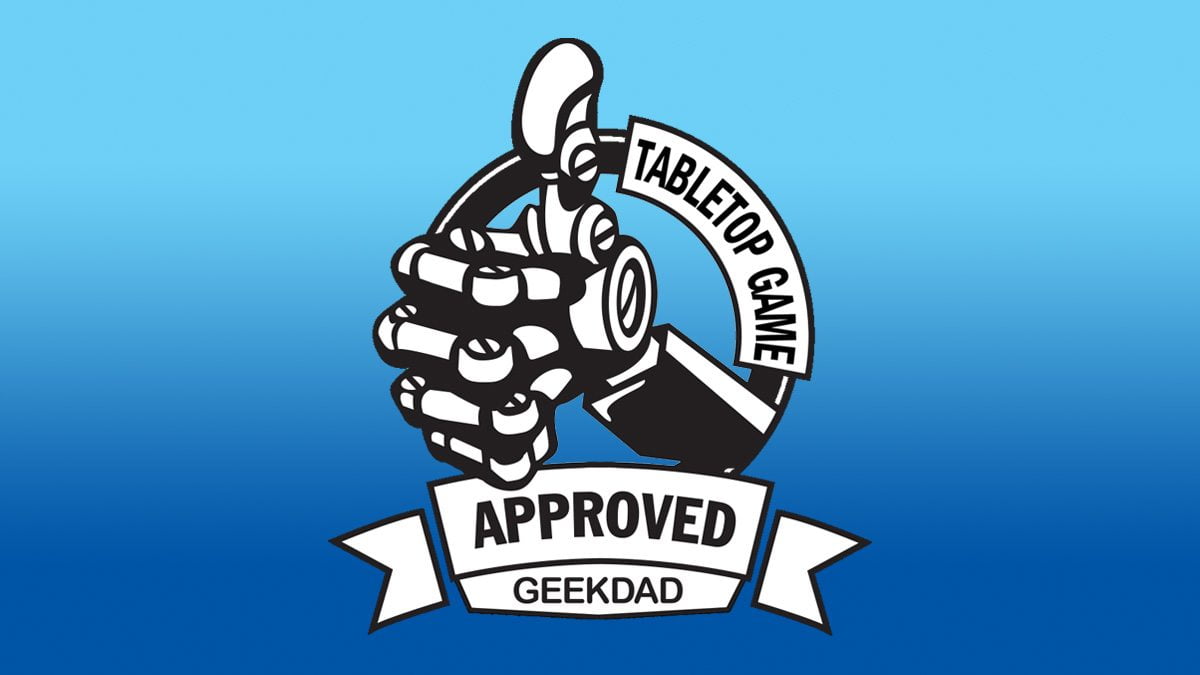
Mississippi Queen is GeekDad Approved!
Why You Should Play Mississippi Queen
Our family played the basic rules for our first game. It was fun and we had a good time. However for the second game we added the Black Rose. That totally changed the game and made it much more enjoyable and even strategic. In the basic game, if you get behind, it can be tough to catch up. However, with the ability to refill your coal with the Black Rose, or to use the Black Rose to push other player’s boats, it really kept the race close.
Mississippi Queen is a quick game to learn and depending on the number of players, only takes 30-45 minutes to play so there is often time for 2-3 races during a gaming session. I really like the management of speed and coal. While high speeds will get you down the river quicker, you are also more likely to burn coal to make several turns during a round. Also, since you have to slow down to a speed of one to pick up passengers, you don’t want to go too fast or you will burn coal to slow down to stop at a dock. The ability to push other players boats also provides tactics to the game since the pushing player gets to determine the space to which the other boat moves. A well-timed push can force another player away from a dock just as they are about to pick up a passenger, possibly costing them an extra turn to get that passenger.
The advanced rules should be used after players have learned the basics of the game. They do not all need to be used together and in fact, playing the hazard tiles along with the Black Rose should only be done by experienced players. Instead, try the Black Rose and then swap it out for some of the hazard tiles. Players can choose which of these advanced tiles to swap out with the basic tiles and the rule book even explains how to do this.
While Mississippi Queen has several mechanics similar to other racing games, it has some unique features such as the cost in coal to make several turns in one round and the ever changing course of the river. The player in the lead needs to be ready to make a change in plans if the new tile placed goes in the opposite direction from what they were anticipating. I highly recommend adding Mississippi Queen to just about everyone’s game collection. Whether you already own a racing game or not, this is a great one that is not only easy to learn but also offers a lot of strategy in order to win.
We liked Mississippi Queen so much, we even made it GeekDad Approved! Check it out on Amazon or from other retailers who sell tabletop games. It also makes a great gift for the gamers in your life.
Click here to see all our tabletop game reviews.
To subscribe to GeekDad’s tabletop gaming coverage, please copy this link and add it to your RSS reader.
Disclosure: GeekDad received a copy of this game for review purposes.
